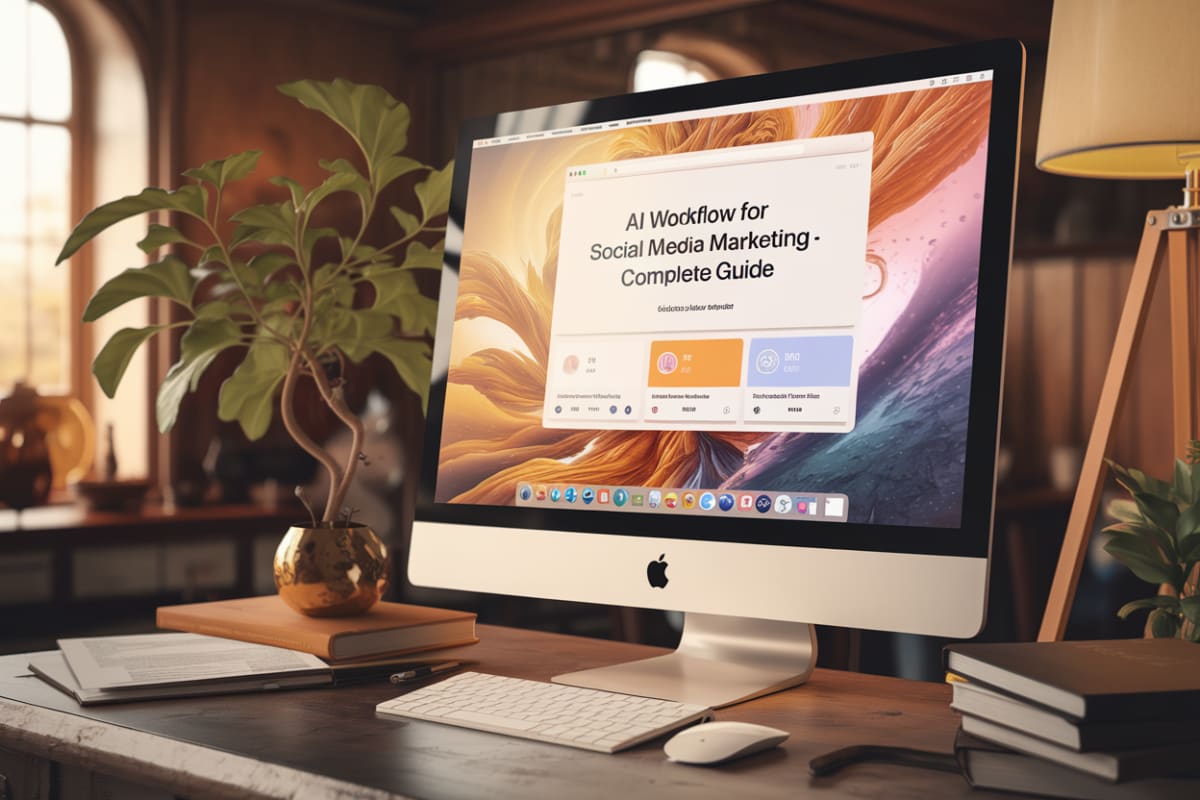Sponsored Post in Social Media Marketing
What is a sponsored post in social media marketing?
Definition of Sponsored Post
A sponsored post represents a social media advertising format where a brand pays a social media platform or an influencer to promote their content to a broader audience than organic reach alone. These posts typically display labels such as "sponsored" or "ad" to indicate they are paid promotions.
Characteristics
Sponsored posts often feature visual elements designed to capture the target audience's attention. The goal remains to drive engagement and conversions by promoting products, services, or brand messages to users likely interested.
Payment Structure
Compensation for sponsored posts varies; brands may pay a flat fee, offer commissions on sales generated, or provide free products in exchange for promotion. Authenticity in the partnership between the brand and the influencer or platform plays a crucial role, as consumers become increasingly skeptical of inauthentic endorsements.
Examples and Case Studies
Hootsuite's Guide: Hootsuite states that a sponsored post allows businesses to promote their products or services to targeted users, significantly enhancing visibility compared to organic reach alone. Hootsuite
Influencer Marketing: Brands often collaborate with content creators who possess a loyal and engaged audience. For instance, a fashion brand may partner with an influencer specializing in outfit inspiration, resulting in authentic content that resonates with followers. Buffer
Regulatory Oversight: A recent report highlights how influencers earn substantial amounts for sponsored posts, particularly in political contexts, showcasing the financial impact of such marketing strategies. Techmeme
By leveraging the established credibility of influencers, sponsored posts can enhance brand trust and reach potential customers in ways traditional advertising may not achieve.
How do sponsored posts work on social media?
Overview of Sponsored Posts
Sponsored posts function as a form of advertising where brands pay influencers or users to promote their products or services through personal accounts. This strategy leverages the influencer's reach and credibility to engage a targeted audience.
Mechanics of Sponsored Posts
Creation: Brands collaborate with influencers to create posts that align with their marketing goals, often including guidelines on messaging, branding, and creative direction.
- Example: A beauty brand may provide an influencer with specific products to demonstrate, along with a script or key points to mention in their post.
Targeting: Platforms like Instagram and Facebook allow brands to target specific demographics based on interests, location, and behavior, ensuring sponsored posts reach the desired audience effectively.
- Case Study: A clothing brand targeting millennials may use insights from previous engagement metrics to select appropriate influencers.
Payment Models: Payment structures vary, including flat fees per post, commission-based payments based on sales generated, or free products in exchange for promotion.
- Example: Influencer Mikey Angelo received payment from a Democratic political action committee for a post encouraging voter turnout, as reported by CNN Business. Such deals can range from hundreds to thousands of dollars based on the influencer’s reach and engagement.
Disclosure: Influencers often must disclose when they receive payment for a post to maintain transparency with their audience, typically using hashtags like #ad or #sponsored.
- Example: Mikey Angelo's post included a disclosure indicating it was a paid partnership, though he wasn't legally required to do so, highlighting a regulatory gap in political endorsements, according to CNN Business.
Impact and Trends
Sponsored posts have become essential in digital marketing strategies, particularly as younger audiences increasingly rely on social media for information and recommendations. Pew Research indicates that about 21% of U.S. adults now depend on social media influencers for news, with the trend more pronounced among younger demographics.
What are the benefits of using sponsored posts?
Increased Brand Trust
Sponsored posts often appear in trusted environments, such as news publications. Research indicates that advertising alongside news content can significantly enhance brand trust. For instance, brands advertising in The Washington Post's political and opinion sections experienced a 55% increase in click-through rates (CTR) compared to other sections. This increase stems from a highly engaged news audience, perceiving such placements as a signal of the brand's investment in quality journalism rather than an endorsement of potentially controversial content.
Targeted Audience Reach
Sponsored posts allow brands to reach specific audience segments effectively. Advertisers tailor their content to resonate with the interests and demographics of the publication's readership. This targeted approach enhances engagement and boosts the likelihood of conversion. Companies aligning their sponsored content with relevant themes capture the attention of readers already inclined to be interested in their offerings.
Enhanced Engagement Metrics
Sponsored posts can lead to higher engagement metrics compared to traditional advertising. The same study from The Washington Post highlights how ads placed within relevant news stories attract greater interest and interaction from readers. When users encounter sponsored content that feels relevant and timely, they engage positively.
Versatility Across Platforms
Sponsored posts can appear across various platforms, including social media, blogs, and podcasts. In podcasting, sponsorships can take the form of host-read ads or pre-recorded messages, allowing for a personal touch that resonates with listeners. This flexibility means brands can choose the format that best fits their audience and message, increasing campaign effectiveness.
Authentic Storytelling Opportunities
Sponsored posts enable brands to tell stories authentically. By integrating messages within valuable content, brands create narratives that emotionally connect with audiences. This approach proves particularly effective in influencer marketing, where influencers share genuine experiences with products, fostering trust and relatability.
Cost-Effective Marketing
Compared to traditional advertising methods, sponsored posts often prove more cost-effective. They usually require lower upfront costs and can deliver better returns on investment when executed correctly. Brands negotiate terms fitting their budgets while still gaining valuable advertising space and audience attention.
In this landscape, consider integrating tools like the AI Social Media Coordinator from Enrich Labs. This innovative solution automates and moderates your social media interactions, allowing your team to focus on crafting authentic stories while saving costs. Customers report 70%+ cost savings and improved engagement, making it a top choice for marketing managers and social media teams.
How much do sponsored posts cost?
Overview of Sponsored Post Costs
Sponsored post costs can vary significantly based on the platform, audience targeting, industry, and advertising strategy. Below is a detailed breakdown by various social media platforms and their associated costs.
General Costs Across Platforms
- Average Daily Cost: $15 to $200
- Monthly Management Fees: $450 to $6,000 (if using an agency)
- Monthly Ad Spend: $200 to over $50,000 Nutshell.
Specific Platform Costs
Instagram:
Facebook:
Twitter (X):
LinkedIn:
YouTube:
- Average CPC: $0.11 to $0.40 WebFX.
Influencer Sponsored Posts
Costs for sponsored posts by influencers also vary:
- Nano-influencers: $40 to $150 per post Inbeat.
- Micro-influencers: $80 to $350 per post Inbeat.
- Mid-tier Influencers: Over $350 per post Inbeat.
- Macro-influencers: Over $1,000 per post Inbeat.
- Mega/Celebrity Influencers: Often $5,000+ per post Inbeat.
How do you create an effective sponsored post?
Research and Identify Target Websites
To create an effective sponsored post, begin with research to identify relevant websites that align with your brand. Check their domain authority and audience engagement to ensure they have a suitable following. If your brand relates to fitness, consider websites focusing on health and wellness.
Create a Compelling Pitch
After identifying potential platforms, craft a personalized pitch that includes multiple topic ideas relevant to the audience of that website. Personalization remains key; mention specific aspects of their content that resonate with your brand.
Understand Guidelines and Follow Them
Understanding and adhering to the guidelines of the collaborating platform is crucial. Respect their word count, style requirements, and avoid overt self-promotion. If a site prefers narrative-driven content, structure your post to tell a story rather than simply listing product attributes.
Write High-Quality, Value-Driven Content
Focus on delivering high-quality content that offers value to readers. Support claims with data and real-life examples. For instance, share a case study or user testimonial relevant to your product, showcasing its benefits through tangible results.
Optimize for Readability and SEO
Utilize headers, lists, and short paragraphs to enhance readability. Incorporate relevant keywords naturally to improve SEO. This approach enhances the discoverability of your sponsored post, increasing its reach and impact.
Engage with Readers and Promote the Post
After the post goes live, actively promote it on social media platforms. Engage with readers by responding to comments and questions, fostering a community around your content. This interaction can significantly increase the visibility and credibility of your sponsored post.
These steps derive from strategies outlined in guides on guest post creation and effective content marketing, emphasizing value and audience engagement as critical components for success in sponsored content marketing. Retail Technology Trends
What platforms are best for sponsored posts?
Facebook and Instagram
Facebook and Instagram rank as top choices for sponsored posts due to their vast user base and robust advertising tools. Facebook boasts over 3.65 billion monthly active users, making it the largest social networking site. According to Michael Stelzner, Facebook offers one of the best options for reaching leads and converting them into sales, with a low cost per action and effective audience targeting capabilities through its Ads Manager. Social Media Examiner
YouTube
YouTube serves as another powerful platform for sponsored posts, especially for brands looking to leverage video content. It boasts 2.5 billion monthly active users, making it the second-largest social media platform. Influencer marketing on YouTube proves particularly effective, with many creators having dedicated followers who trust their recommendations. Influencers like Emma Chamberlain and Marques Brownlee successfully integrate sponsored content into their videos, yielding high engagement and ROI for brands. Hootsuite
TikTok
TikTok has rapidly gained popularity, especially among younger audiences. Its engaging short-form video content offers unique opportunities for brands to collaborate with influencers and run sponsored posts. Brands can utilize TikTok's ad features to create authentic content that resonates with the platform's user base. High Social
Twitch
Twitch emerges as an appealing platform for sponsored posts, particularly for brands targeting Gen Z and millennials. The platform allows for high-impact video ads and creator-driven sponsorships, creating deep connections with the audience. Twitch's audience primarily consists of users aged 18-34, making it a prime target for brands looking to engage a younger demographic. Amazon Ads
For B2B companies, LinkedIn stands as an excellent platform for sponsored posts, especially with its professional user base. LinkedIn tests new ad formats like the 'News Banner' and is expected to generate significant revenue for publishers through its ad programs. Techmeme
In summary, the best platforms for sponsored posts include Facebook, Instagram, YouTube, TikTok, Twitch, and LinkedIn, each offering unique advantages depending on the target audience and marketing goals.
How do sponsored posts differ from organic posts?
Definition
Sponsored Posts: Sponsored posts represent paid advertisements brands use to promote their products or services. They appear on social media platforms and usually carry labels as advertisements, distinguishing them from regular user-generated content. On platforms like Facebook and Instagram, these posts target specific audiences based on demographics, interests, and behaviors.
Organic Posts: Organic posts consist of content shared by users or brands without any payment to promote visibility. These posts rely on the platform's algorithm to determine their reach, influenced by factors such as engagement, relevance, and the user's connections.
Key Differences
Payment: The most significant difference lies in payment; sponsored posts require payment to the platform for enhanced visibility and reach, while organic posts are free to post but may not reach as many users due to algorithmic constraints.
Visibility: Sponsored posts often receive prioritization in feeds, appearing at the top or in dedicated ad spaces. For instance, Google Ads shows sponsored results prominently labeled as 'Ads' at the top or side of the search results page, while organic results appear based on relevance and popularity. Google Support
Content Control: Brands maintain more control over sponsored content, including format, message, and targeting strategy. Organic posts, however, remain subject to the platform's algorithm and audience engagement. A brand may invest in sponsored content on platforms like Instagram using techniques like Meta’s Advantage Plus features to automate and optimize ad delivery, potentially reaching a broader audience than organic posts allow. Social Media Examiner
Engagement Metrics: Sponsored posts often provide clearer metrics for success, such as click-through rates and conversions, trackable through advertising dashboards. Organic posts may achieve higher engagement due to perceived authenticity but can be harder to measure quantitatively.
Audience Perception: Sponsored posts can sometimes appear less trustworthy compared to organic content, as audiences recognize them as advertisements. Organic posts may foster stronger connections due to their authentic nature. Influencer marketing exemplifies this, as brands collaborate with content creators whose endorsements audiences trust, even when compensated for their posts. Buffer
Case Study Example
A practical example involves VKTRY, a company that experienced significant growth through organic social strategies. Their effective use of organic content led to massive engagement, vastly outperforming paid efforts and demonstrating how organic reach can enhance overall brand visibility and revenue. Operators Content
In summary, sponsored and organic posts serve different strategic purposes in digital marketing. Brands often use a combination of both to maximize reach and effectiveness.
Consider exploring the AI Social Media Coordinator from Enrich Labs. This tool streamlines social media management, enabling brands to maintain a consistent voice and respond swiftly to interactions—addressing the pain points of overwhelmed marketing teams.
Conclusion
Sponsored posts act as a bridge between brands and consumers, utilizing the trust influencers have built with their audiences. As this practice evolves, balancing effective marketing and ethical transparency remains critical. For optimal efficiency and enhanced customer engagement, explore how the AI Social Media Coordinator can transform your social media strategy—visit Enrich Labs to learn more.




